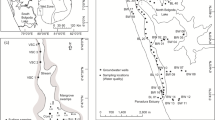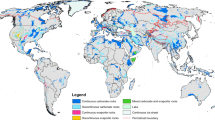Abstract
The authors have carried out scientific investigations of salt lakes on the Qinghai-Tibet Plateau since 1956 and collected 550 hydrochemical data from various types of salt lakes. On that basis, combined with the tectonic characteristics of the plateau, the hydrochemical characteristics of the salt lakes of the plateau are discussed. The salinity of the lakes of the plateau is closely related to the natural environment of lake evolution, especially the climatic conditions. According to the available data and interpretation of satellite images, the salinity of the lakes of the plateau has a general trend of decreasing from north and northwest to south and southeast, broadly showing synchronous variations with the annual precipitation and aridity (annual evaporation/annual precipitation) of the modern plateau. The pH values of the plateau salt lakes are related to both hydrochemical types and salinities of the lake waters, i.e., the pH values tend to decrease from the carbonate type → sodium sulfate subtype → magnesium sulfate subtype → chloride type; on the other hand, a negative correlation is observed between the pH and salinities of the lakes. Geoscientists and biological limnologists generally use main ions in salt lakes as the basis for the hydrochemical classification of salt lakes. The common ions in salt lakes are Ca2+, Mg2+, Na+, K+, Cl− SO4 2−, CO3 2−, and HCO3 −. In this paper, the Kurnakov-Valyashko classification is used to divide the salt lakes into the chloride type, magnesium sulfate subtype, sodium sulfate subtype and carbonate type, and then according to different total alkalinities (K C = Na2CO3 + NaHCO3/total salt × 100%) and different saline mineral assemblages, the carbonate type is further divided into three subtypes, namely, strong carbonate subtype, moderate carbonate subtype and weak carbonate subtypes. According to the aforesaid hydrochemical classifications, a complete and meticulous hydrochemical classification of the salt lakes of the plateau has been made and then a clear understanding of the characteristics of N–S hydrochemical zoning and E-W hydrochemical differentiation has been obtained. The plateau is divided into four zones and one area. There is a genetic association between certain saline minerals and specific salt lake hydrochemical types: the representative mineral assemblages of the carbonate type of salt lake is borax (tincalconite) and borax-zabuyelite (L2CO3) and alkali carbonate-mirabilite; the representative mineral assemblages of the sodium sulfate subtype are mirabilite (thenardite)-halite and magnesium borate (kurnakovite, inderite etc.)-ulexite-mirabilite; the representative mineral assemblages of the magnesium sulfate subtype are magnesium sulfate (epsomite, bloedite)-halite, magnesium borate-mirabilite, and mirabilite-schoenite-halite, as well as large amount of gypsum; The representative mineral assemblages of the chloride type are carnallite-bischofite-halite and carnallite-halite, with antarcticite in a few individual salt lakes. The above-mentioned salt lake mineral assemblages of various types on the plateau have features of cold-phase assemblages. Mirabilite and its associated cold-phase saline minerals are important indicators for the study of paleoclimate changes of the plateau. A total of 59 elements have been detected in lake waters of the plateau now, of which the concentrations of Na, K, Mg, Ca, and Cl, and SO4 2−, CO3 2−, and HCO3 − ions are highest, but, compared with the hydrochemical compositions of other salt lake regions, the plateau salt lakes, especially those in the southern Qiangtang carbonate type subzone (I2), contain high concentrations of Li, B, K, Cs, and Rb, and there are also As, U, Th, Br, Sr, and Nd positive anomalies in some lakes. In the plateau lake waters, B is intimately associated with Li, Cs, K and Rb and its concentration shows a general positive correlation with increasing salinity of the lake waters. The highest positive anomalies of B, Li, Cs, and K center on the Ngangla Ringco Lake area in the western segment of the southern Qiangtang carbonate type subzone (I2) and coincide with Miocene volcanic-sedimentary rocks and high-value areas of B, Li, and Cs of the plateau. This strongly demonstrates that special elements such as B, Li, and Cs on the plateau were related to deep sources. Based on recent voluminous geophysical study and geochemical study of volcanic rocks, their origin had close genetic relation to anatectic magmatism resulting from India–Eurasia continent–continent collision, and B–Li (-Ce) salt lakes in the Cordillera Plateau of South America just originated on active continental margins, both of which indicate that global specific tectonically active belts are the main cause for the high abundances of B, Li, and Cs (K and Rb) in natural water and mineralization of these elements.






Similar content being viewed by others
References
Alonso RN (1999) On the origin of La Puna Borates. Acta Geol Hispanica 34(2–3):141–166
Alonso RN, Viramonte JG (1985a) Geyseres boratiferos de la puna Argentina. IV Congreso Geologico Chileno, Agosto, pp 3–23
Alonso RN., Viramonte JG (1985b) Provincia boratifera centroandina. IV Congreso Geologico Chileno, Agosto, pp 3–45
Alonso RN, Viramonte JG (1993c) La cuestion genetica de los boratos de la puna. XII Congreso Geologico Argentino y II Congreso de Explorloration de Hidrocarbururos, pp 187–194 (in Spain with English abstract)
Fernando IY, Kunasz IA (1989) Origin of lithium in Salar de Atacama, Northern Chile. In: Ericksen GE, Cãnas Pinochet MT, Reinemund JA (eds) Geology of the Andes and its relation to hydrocarbon and mineral resources, vol 11. Circum Pacific Council for Energy and Mineral Resources Earth Science Series, Houston, Texas, pp 165–172
Fernando IY, Luis VE, Pedro PZ (1983) Solar pond design for the production of potassium salts from the Salar de Atacama brines. In Proceeding of the Sixth International Symposium on Salt 2: 367–394, Published by the Salt Institute
Ferretti JI, Alonso RN (1993) Geoquimica del campo geotermico tocomar (salta). XII Congreso Geologico Argentino y II Congreso de Explorloration de Hidrocarbururos, pp 311–316 (in Spain with English abstract)
González OE (1984) Las ignimbritas de “ojo de ratones” y sus relaciones regionales, provincia de salta. Noveno Congreso Geologico Argentino, pp 206–220 (in Spain with English abstract)
Jordan TE, Alonso RN, Godfrey LV (1999) Tectonica, subsidencia y aguas en el salar del Hombre Muerto, Puna. XIV Congreso Geologico Argentino, Actas I, Salta (in Spain with English abstract)
Lerman A (1967) Model of chemical evolution of a chloride lake, the Dead Sea. Geochim Cosmochim Acta 31(12):2307–2330
Lin Y, Zhang H, Zheng M (1990) The crystal structure of zabuyelite. Chin Sci Bull 35(6):489–492 (in Chinese with English abstract)
Qiu Y, Xie X, Qian Z, Liu L (1964) Hungchaoite—a new hydrous magnesium borate mineral. Acta Geol Sin 44(3):351–356 (in Chinese)
Sherwood M (1970) Sea of chemicals. Chemistry 43(7):34–36
Smith GI (1966) Geology of Searles Lake—A guide to prospecting for buried continental salines. In: Rau (ed) 2nd Symposium on Salt, Cleveland, Ohio, pp 167–180
Smith GI (1976) Origin of lithium and other components in the Searles Lake evaporites, California. In: Vine JD (ed) Lithium resources and requirements by the year 2000. Geological Survey Professional Paper 1005, pp 92–103
Smith GI (1979) Subsurface stratigraphy and geochemistry of lake Quaternary evaporite, Searlies Lake, California. U.S. Geological Survey, Prof. 1043 p 98–100
Sun H, Liao K, Pan Y, Wang J (1990) Atlas of the Qinghai-Tibet Plateau. Science Press, Beijing, p 17, 67, 69 (in Chinese)
Tong W, Zhang M, Zhang Z (1981) Geothermal field in Tibet. Science Press, Beijing (in Chinese)
Turekian KK, Wedepohl KH (1961) Distribution of the elements in some major units of earth’s crust. Geol Soc Am Bull, 72:175–192
Vinogpadov AP (1992) Mean values of elements of all types of rock in the world. Geochemistry 7:1009–1027 (in Russian)
Xie X, Cha F (1993) Mineral physics of borates. Seismological Press, Beijing (in Chinese with English abstract)
Xie X, Zheng M (1963a) Preliminary research on inderite discovered in China. Sci China 12(8):1246–1248 (in Russian)
Xie X, Zheng M (1963b) Research on kurnakovite crystals. Acta Geol Sin 43(2):184–191 (in Chinese with Russian abstract)
Xie X, Zheng M (1964) Kurnakovite crystals: revisited. Geol Rev 22(1):35–37 (in Russian)
Xie X, Qian Z, Liu L (1964) Carboborite—a new borate mineral. Sci Geol Sin 1:91–99 (in Chinese)
Xie X, Zheng M, Liu L (1965) Borate minerals. Science Press, Beijing (in Chinese)
Zhang PX (1987) Saline lakes in the Qaidam basin. Science Press, Beijing (in Chinese)
Zheng M (1997) An introduction to saline lakes on the Qinghai-Tibet Plateau. Kluwer Academic Publishers, Dordrecht, p 168
Zheng M (2001a) New progress in the study of saline lake resources on the Qinghai-Tibet Plateau. Acta Geosci Sin 22(2):97–102 (in Chinese with extended English abstract)
Zheng M (2001b) On saline lakes of China. Miner Depos 20(2):181–189, 128 (in Chinese with English abstract)
Zheng M (2001c) Study advances in saline lake resources on the Qinghai-Tibet Plateau. Acta Geosci Sin 22(2):97–102 (in Chinese with English abstract)
Zheng M, Jin W (1964) A new type of magnesium borate deposit in a certain area of China. Chin Geol 2:24–30 (in Chinese)
Zheng M, Liu W (1987a) Zabuyelite, a new lithium mineral. Geol Rev 33(4):365–368 (in Chinese with English abstract)
Zheng M, Liu W (1987b) A new Li-mineral-Zabuyelite. Acta Mineral Sin 7(3):221–226 (in Chinese with English abstract)
Zheng M, Liu W, Jin W (1981) A study on the Xizang (Tibet) salt minerals. Bull Chin Acad of Geol Sci 2(1):75–101 (in Chinese with English abstract)
Zheng M, Liu X, Liu J, Wei L (2003). Report on the results of the investigation and evaluation of resources in the Qiangtang Salt Lake, Tibet. Internal document of the Institute of Mineral Resources, Chinese Academy of Geological Sciences (in Chinese)
Zheng M, Xiang J, Wei X, Zheng Y (1989) Saline lakes on the Qinghai-Xizan (Tibet) Plateau. Beijing Scientific and Technical Publishing House, Beijing (in Chinese)
Zheng M, Yuan H, Liu J, Li Y, Ma Z, Sun Q (2007) Sedimentary characteristics and paleoenvironmental records of Zabuye Salt Lake, Tibet Plateau, since 128 ka. Acta Geol Sin 81(5):861–874
Zheng M, Zhao Y, Liu J (1998) Quaternary saline lake deposits and paleoclimate. Quaternary Sciences 4:297–307 (in Chinese with English abstract)
Acknowledgments
This study was supported by the project of China Geological Survey (Nos. 1212010633804 and 1212010630109) and National Natural Science Foundation of China (grant 40531002). We are grateful to the National Research Center of Geoanalysis and Institute of Hydrogeology and Engineering Geology of the Ministry of Land and Resources, Qinghai Saline Lake Institute of the Chinese Academy of Sciences, and Si Dongxing, Liu Jianhua and others of our laboratory for chemical analysis, to Fei Zhenbi, Wang Mai, and Liu Yuxia for assistance in indoor preparation of the manuscript, and to two anonymous reviews for their helpful comments.
Author information
Authors and Affiliations
Corresponding author
Rights and permissions
About this article
Cite this article
Zheng, M., Liu, X. Hydrochemistry of Salt Lakes of the Qinghai-Tibet Plateau, China. Aquat Geochem 15, 293–320 (2009). https://doi.org/10.1007/s10498-008-9055-y
Received:
Accepted:
Published:
Issue Date:
DOI: https://doi.org/10.1007/s10498-008-9055-y




